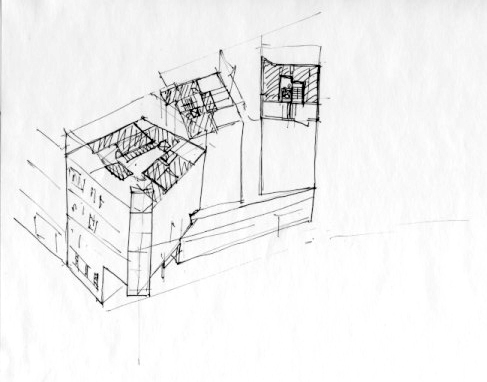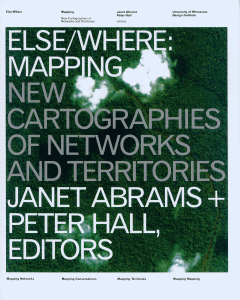I received a number of interesting comments from folks on the recent Blogitecture panel with Kazys Varnelis and Mark Jarzombek at MIT [slideshow; my own text here on javierest]. Without putting words into their mouths (actual comments to follow in just a moment…), the most common criticism, in my interpretation, is that for all that was potentially powerful about the event, we failed at the same time to sufficiently address what blogs are doing to architectural production, or how they function as a form of architectural production in and of themselves. I can only add as a bit of an ‘out’ that the invitation to the panel asked us to think about the state of criticism and the possibilities for criticism, instead of talking about production. (Whether or not blogging is or ever was a form of “outside” criticism, as the general theme of the MIT HTC forum seemed to suggest, is another matter of debate).
Of course, one could ask what is criticism without the flip side of production? One makes the other (and neither one can be said to come first). Well, part of the problem may be, as I think Kazys Varnelis alluded to in an earlier email, is that it might be too soon to tell how production is changing… On the other hand, as some of the following comments will point to, it’s becoming clear that architecture students, for example, are already reinventing the ways in which ideas, an audience, and design development stack up on each other, altering the traditional chronologies of these processes along the way. Maybe a few practicing architects are doing so as well. In that sense, these comments are right on because theory and criticism are probably changing as we speak, hand in hand with production, and we have to try to get a better sense of how to frame the issue.
These comments are edited down for length, still trying to preserve the integrity of the ideas… And thanks for offering these, folks… Any omissions that would change the general sense of the original thoughts would be my own fault. Added links come from me.
Selections from an email by Enrique Ramirez [a456], on April 12, 2009:
One thing, for certain, it should be said that architecture websites are not “outside” forms of dialogue. Blogs, etc, are architecture production. Blogs do not influence architecture practice. Rather, they are part of it (ask Sam Jacob or Charles Holland). I also wonder if a new type of writing is on the horizon, one that is dictated by the conditions of online production. And on that note, I think more should be said about content. Whereas Mimi Zeiger’s Studio X panels seemed to cover a lot of the tools of online publishing (indexhibit, etc, etc), and the MIT HTC forum was a very significant and successful attempt at theorizing the state of architecture blogging and criticism, more needs to be said about how and why some things are ripe for coverage on blogs.
I say this because many, many of the blogs that I read seem to engage architecture in terms of their spatial qualities, and often not much else. Where’s talk about form, history, production, labor, etc?
Bryan Finoki, Subtopia, wrote on April 23, 2009:
The event only seemed to focus on one aspect of blogging: the consumptive side, and looked too generally I thought at the blogosphere rather broadly on the whole, and didn’t really get into the niche of architectural blogging.
The production side is where I see a lot of value there – people writing their own blogs, bringing in a written layer of self-reflexivity to their design process, learning how to talk about their work and others, thinking about architecture as perhaps it can only exist in written words.
I think this exploration would be far more interesting than the basic critiques of blogs as conduits for relaying other work, and as these popularity contests geared to drive traffic, the tricks and hooks bloggers use to attract readers, and so forth. I thought that critique was trite at this point, cliche criticism, frankly.
What is blogging actually doing for architecture, as a practice, in education (for students, faculty, adminsitraton), as design, as broadening what is often a narrow scope of what and how architecture can be referred to today? Has blogging impacted architectural relevancy on a wider scale? These seemed like questions that never got answered.
From Nam Henderson on April 14, 2009:
As for the impact of the “more accelerated pace of blogging and the production of architecture”, I think within the Archinect school blogs and various non-Archinect thesis blogs one does see a link between the dialogic aspect of blogging, and the end product. In this case though i suppose the question becomes is this any different than the dialogic process within studio. But the blog as studio writ large? And even if so, does this only become interesting once applicable within the actual built realm?
[NB. Elsewhere, see also some running commentary on Archinect… ]
It seems that the fact of the matter is that there is a lot more to learn about the complex networks taking shape somewhere between spaces of production (studio, office, library, etc), blogs, and the human brains that power all these. These inherently are spaces of making and critiquing as part and parcel of each other. As much as I also agree with the above comments, especially with Enrique’s point about the “oneness” of architecture and blogging, we also have to keep in mind that blogs still owe more to a production ideology rooted in Silicon Valley culture than to architecture’s various streams. Where it could get really interesting is if architecture blogs actually started to publish in experimental and markedly different ways from the blogosphere in general – without falling into the trap of making flash graphics, but striving for truly new social relations.
Now, not to suggest that any of the above comments are guilty of the following -because they simply aren’t- ultimately my own fear is that we often get carried away with the boosterism, asserting that any new reconfiguration of the relation between theory and making is a good one or that any free online technology is inherently democratic, and therefore would open up the design process or the politics of building and land use.
My own point in the panel really came down to trying to show that there are real social relations under the surface that often close off opportunity as much as they open it. I’m asking here if it’s even possible to start to know what’s happening to production if we don’t take a step back and understand the social realm in which that production is happening — or how blogging along with social networking of various sorts reshape relations of labor and, therefore, of spaces.
In addition, architecture—as a spatial discipline—is well-poised to examine and understand the kinds of spaces that blogs are producing. Are they actually as democratic as we think? Even if the multitiudes were fully participating (though, are they?), are blogs and such replacing more entrenched spatialities of gender, age, or race divisions?
Maybe these are still some open questions that, if addressed seriously, can expand the current objects of study in architecture which too often focus singularly on stuff like the suburbs, for example, in an atemporal and spatially isolated way, rather than treating these as relational and networked spaces. More important still, let’s address architecture’s rote presentation mechanisms. This last item—the dogmatic conventions of making and representing space—surprisingly have not changed much at all, while the world around them has definitely shifted. (Credit is certainly due there to Architecture for Humanity and its Open Architecture Network, for showing us one alternative model).
Finally, the fact that more and more architecture students now blog in and of itself perhaps is not interesting. What is interesting is the reactionary response this awakens from the academies, which have not allowed things like the vaunted thesis project to actually challenge the discipline with these new tools so far that I have seen. (Maybe it’s no coincidence that some of the more interesting work today is in design interaction departments). One of the only people, at least that I know of, that have realized the fact that architecture’s disciplinary boundaries have to change in this new context (and has also thought about how they might) is Bryan Boyer, who wrote for loudpaper: ” The work of the architect has never been more tied to all the specificities of client, market, place, and politics nor have the concerns of these groups ever been more enmeshed. Each format has its own set of catalytic constraints, biases, and conventions that the architect must work with.” That ‘format’ that Bryan Boyer discusses in the previous post is up for grabs—that much we now know—but have the schools or the established architects actually caught on?







